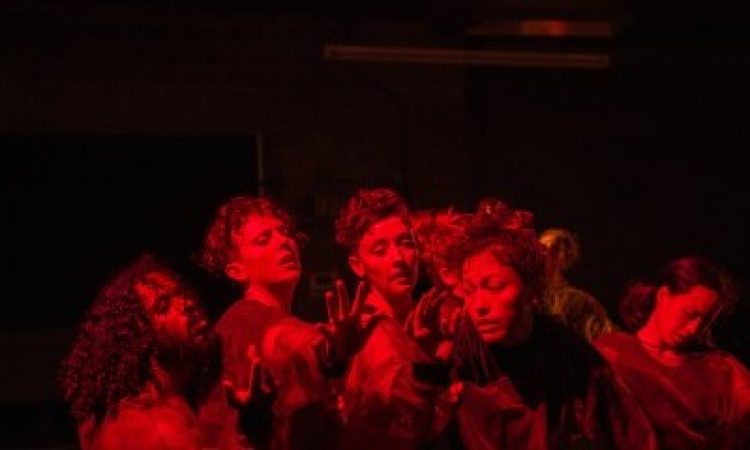You can start with your mouth.
Shannon Murphy’s amplified voice wafts over us amidst a pulsating techno beat. The stage is awash with dancers: reclining, eyes closed, tranquil. Supine and speaking into a microphone she asks them, and perhaps the audience as well, to consider which parts of their mouths constitute the inside of them, which parts remain outside, and which parts they cannot distinguish as either. The nine dancers writhe softly, slack-jawed, eventually moving from floor-bound beings to upright as Murphy uses verbal cues to guide sensation down the digestive tract.
mouth
esophagus
stomach
small intestine
large intestine
rectum
anus
Their easeful, exploring bodies occupy a somatic space upon which the party music forms a light tension. I watch their pelvises shift and gyrate, thinking of the intestines beneath.
What if this body doesn’t need anything? What if this body only wants?
In the ensuing improvisatory world, the group exhibits moments of both unity and swift change. At various points dancers subtract themselves from the group in order to change the room’s music on an iPad. In one of the rare moments of speech onstage, Patricia Dominguez dances with Marisa Illingworth and asks, “I want you to stick out your tongue while you dance,” and “I want to sit on your back,” while Illingworth responds with more childlike appeals such as, “Spin me around like an airplane ride.” At times they comply with the other’s requests, and at others they pour and spill into each other with abandon, seemingly with other goals in mind.
Toward the end of the piece, Murphy addresses the audience directly. The music is loud, and her voice is frenzied. After recounting an embarrassing social interaction, she slows down to describe a more serene moment: looking out over open hills, staring at cows who just “chew and chew and chew.” She then re-enters the group dance. I think of the mouth and its role as the communicator, full of messy language; the mouth as the first part of the system by which we meet our basic bodily needs.
Before the piece begins, we are invited to walk around the space. Posted on the walls are photos of the dancers improvising, with superimposed pink lines tracing their gastrointestinal tracts. The program, a thick paper cut and folded back over itself so many times it resembles an accordion (or maybe an intestinal tube), contains quotes from each of the dancers about their relationship to the work. The words “support,” “guts,” “community,” and “joy” resurface throughout its folds. The dancers have been working on this project for nearly two years and have co-created a world with its own life and logic. Their desire to be collective is palpable to me through their smiles, searching limbs, and audible exhales. At times, when they cradle each other, share laughter and knowing looks amidst scattered phrase work, I feel very much outside of the world before me, looking in. I grope around in my somatic-dancer brain, recollect my experience of taking Shannon’s sensuous and anatomically-minded modern class, search for tools with which to make sense of their system. I ponder how it feels from the inside.
Dark Moon, Shannon Murphy, Archedream Studio, May 10.






